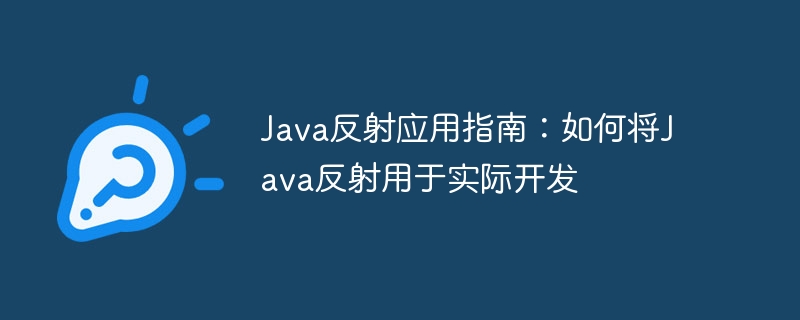Home >Java >javaTutorial >Java Reflection Application Guide: How to use Java reflection for practical development
Java Reflection Application Guide: How to use Java reflection for practical development
- WBOYWBOYWBOYWBOYWBOYWBOYWBOYWBOYWBOYWBOYWBOYWBOYWBforward
- 2024-02-19 18:03:20551browse

php editor Strawberry will take you to explore the Java reflection application guide and discuss how to flexibly use Java reflection technology in actual development. Through this guide, you will understand the basic concepts and principles of reflection, and how to use reflection to achieve practical operations such as dynamically creating objects and calling methods. An in-depth understanding of Java reflection will help you respond to various needs more efficiently and flexibly during project development.
JavaReflectionThe mechanism is implemented through the reflectionapi provided by JavaVirtual Machine, which mainly includes the following core classes:
- Class: Represents Java class or interface
- Method: Represents Java method
- Field: Represents Java field
- Constructor: Represents Java constructor
By using these classes, the information and behavior of the class can be dynamically obtained and modified, for example:
Class cls = Class.forName("com.example.MyClass");
Method method = cls.getMethod("myMethod", String.class, int.class);
Object result = method.invoke(cls.newInstance(), "argument1", 10);
This code calls the myMethod method of the MyClass class through reflection and passes two parameters.
2. Common application scenarios of Java reflection
Java reflection is widely used in actual development. Here are some common application scenarios:
- Dynamic type checking: The type of an object can be checked through reflection, for example:
if (object instanceof MyClass) {
// do something
}
- Dynamic method calling: Methods can be called dynamically through reflection, for example:
Method method = object.getClass().getMethod("myMethod", String.class, int.class);
Object result = method.invoke(object, "argument1", 10);
- Dynamic field access: Fields can be accessed dynamically through reflection, for example:
Field field = object.getClass().getField("myField");
Object value = field.get(object);
- Dynamic class creation: Classes can be created dynamically through reflection, for example:
Class cls = Class.forName("com.example.MyClass");
Object object = cls.newInstance();
- API exploration: Java API can be explored through reflection, for example:
for (Method method : cls.getMethods()) {
System.out.println(method.getName());
}
3. Things to note about Java reflection
The Java reflection mechanism is very powerful, but you also need to pay attention to the following points:
- Performance overhead: Reflection is slower than calling methods or fields directly, so it should be used with caution in performance-sensitive scenarios.
- Security: Reflection can bypass access control, so you should pay attention to security when using reflection, such as avoiding using reflection to access private fields or methods.
- Stability: Reflection relies on the JVM implementation, so there may be different behaviors on different JVM versions or different operating systems.
4. Summary
The Java reflection mechanism is a powerful tool that can help developers better understand and operate Java code and has a wide range of applications in actual development. However, when using reflection, you also need to pay attention to its performance overhead, security, and stability.
The above is the detailed content of Java Reflection Application Guide: How to use Java reflection for practical development. For more information, please follow other related articles on the PHP Chinese website!

